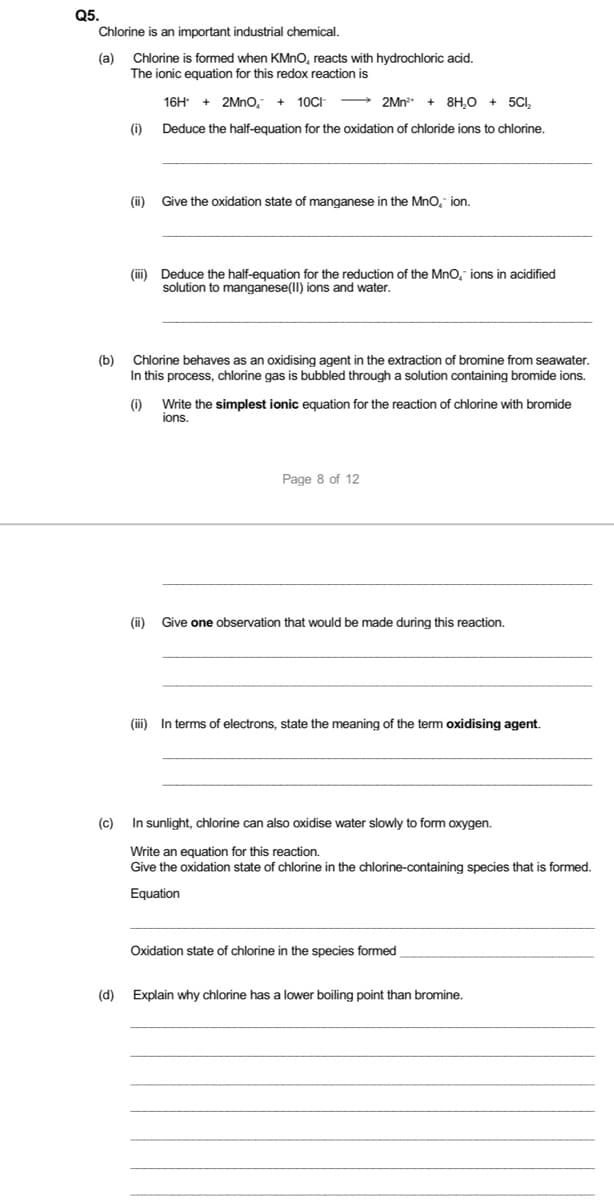Q5. Chlorine is an important industrial chemical. (a) Chlorine is formed when KMNO, reacts with hydrochloric acid. The ionic equation for this redox reaction is 16H + 2MNO, 10CI → 2Mn" + 8H,0 + 5CI, (i) Deduce the half-equation for the oxidation of chloride ions to chlorine. (ii) Give the oxidation state of manganese in the MnO, ion. (iii) Deduce the half-equation for the reduction of the Mno, ions in acidified solution to manganese(ll) ions and water. (b) Chlorine behaves as an oxidising agent in the extraction of bromine from seawater. In this process, chlorine gas is bubbled through a solution containing bromide ions. (i) Write the simplest ionic equation for the reaction of chlorine with bromide ions. Page 8 of 12 (i) Give one observation that would be made during this reaction. (iii) In terms of electrons, state the meaning of the term oxidising agent. (c) In sunlight, chlorine can also oxidise water slowly to form oxygen. Write an equation for this reaction. Give the oxidation state of chlorine in the chlorine-containing species that is formed. Equation Oxidation state of chlorine in the species formed (d) Explain why chlorine has a lower boiling point than bromine.
Q5. Chlorine is an important industrial chemical. (a) Chlorine is formed when KMNO, reacts with hydrochloric acid. The ionic equation for this redox reaction is 16H + 2MNO, 10CI → 2Mn" + 8H,0 + 5CI, (i) Deduce the half-equation for the oxidation of chloride ions to chlorine. (ii) Give the oxidation state of manganese in the MnO, ion. (iii) Deduce the half-equation for the reduction of the Mno, ions in acidified solution to manganese(ll) ions and water. (b) Chlorine behaves as an oxidising agent in the extraction of bromine from seawater. In this process, chlorine gas is bubbled through a solution containing bromide ions. (i) Write the simplest ionic equation for the reaction of chlorine with bromide ions. Page 8 of 12 (i) Give one observation that would be made during this reaction. (iii) In terms of electrons, state the meaning of the term oxidising agent. (c) In sunlight, chlorine can also oxidise water slowly to form oxygen. Write an equation for this reaction. Give the oxidation state of chlorine in the chlorine-containing species that is formed. Equation Oxidation state of chlorine in the species formed (d) Explain why chlorine has a lower boiling point than bromine.
Chemistry: The Molecular Science
5th Edition
ISBN:9781285199047
Author:John W. Moore, Conrad L. Stanitski
Publisher:John W. Moore, Conrad L. Stanitski
Chapter3: Chemical Reactions
Section: Chapter Questions
Problem 57QRT
Related questions
Question

Transcribed Image Text:Q5.
Chlorine is an important industrial chemical.
(а)
Chlorine is formed when KMNO, reacts with hydrochloric acid.
The ionic equation for this redox reaction is
16H + 2Mno, + 10CH
→ 2Mn"
+ 8H,0 + 5CI,
(i)
Deduce the half-equation for the oxidation of chloride ions to chlorine.
(i)
Give the oxidation state of manganese in the Mno, ion.
(ii) Deduce the half-equation for the reduction of the MnO, ions in acidified
solution to manganese(lI) ions and water.
(b)
Chlorine behaves as an oxidising agent in the extraction of bromine from seawater.
In this process, chlorine gas is bubbled through a solution containing bromide ions.
(i)
Write the simplest ionic equation for the reaction of chlorine with bromide
ions.
Page 8 of 12
(i)
Give one observation that would be made during this reaction.
(iii) In terms of electrons, state the meaning of the term oxidising agent.
(c)
In sunlight, chlorine can also oxidise water slowly to form oxygen.
Write an equation for this reaction.
Give the oxidation state of chlorine in the chlorine-containing species that is formed.
Equation
Oxidation state of chlorine in the species formed
(d)
Explain why chlorine has a lower boiling point than bromine.
Expert Solution
This question has been solved!
Explore an expertly crafted, step-by-step solution for a thorough understanding of key concepts.
This is a popular solution!
Trending now
This is a popular solution!
Step by step
Solved in 2 steps with 2 images

Knowledge Booster
Learn more about
Need a deep-dive on the concept behind this application? Look no further. Learn more about this topic, chemistry and related others by exploring similar questions and additional content below.Recommended textbooks for you

Chemistry: The Molecular Science
Chemistry
ISBN:
9781285199047
Author:
John W. Moore, Conrad L. Stanitski
Publisher:
Cengage Learning

Chemistry: Principles and Reactions
Chemistry
ISBN:
9781305079373
Author:
William L. Masterton, Cecile N. Hurley
Publisher:
Cengage Learning

Chemistry
Chemistry
ISBN:
9781305957404
Author:
Steven S. Zumdahl, Susan A. Zumdahl, Donald J. DeCoste
Publisher:
Cengage Learning

Chemistry: The Molecular Science
Chemistry
ISBN:
9781285199047
Author:
John W. Moore, Conrad L. Stanitski
Publisher:
Cengage Learning

Chemistry: Principles and Reactions
Chemistry
ISBN:
9781305079373
Author:
William L. Masterton, Cecile N. Hurley
Publisher:
Cengage Learning

Chemistry
Chemistry
ISBN:
9781305957404
Author:
Steven S. Zumdahl, Susan A. Zumdahl, Donald J. DeCoste
Publisher:
Cengage Learning

Chemistry & Chemical Reactivity
Chemistry
ISBN:
9781337399074
Author:
John C. Kotz, Paul M. Treichel, John Townsend, David Treichel
Publisher:
Cengage Learning

Chemistry & Chemical Reactivity
Chemistry
ISBN:
9781133949640
Author:
John C. Kotz, Paul M. Treichel, John Townsend, David Treichel
Publisher:
Cengage Learning

Chemistry: An Atoms First Approach
Chemistry
ISBN:
9781305079243
Author:
Steven S. Zumdahl, Susan A. Zumdahl
Publisher:
Cengage Learning